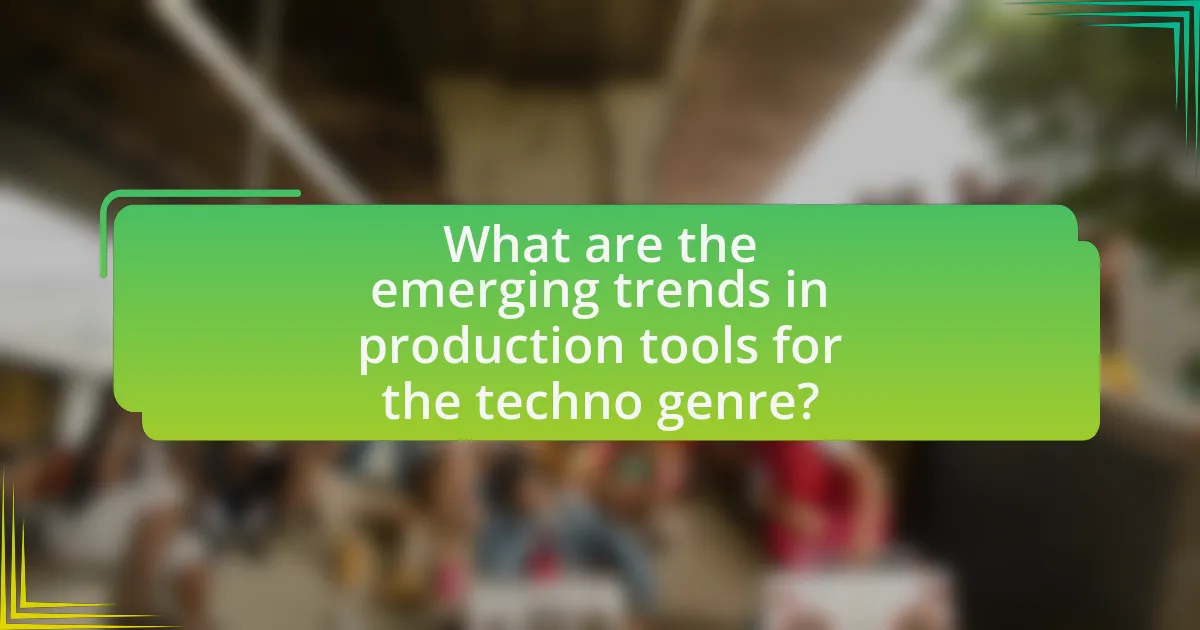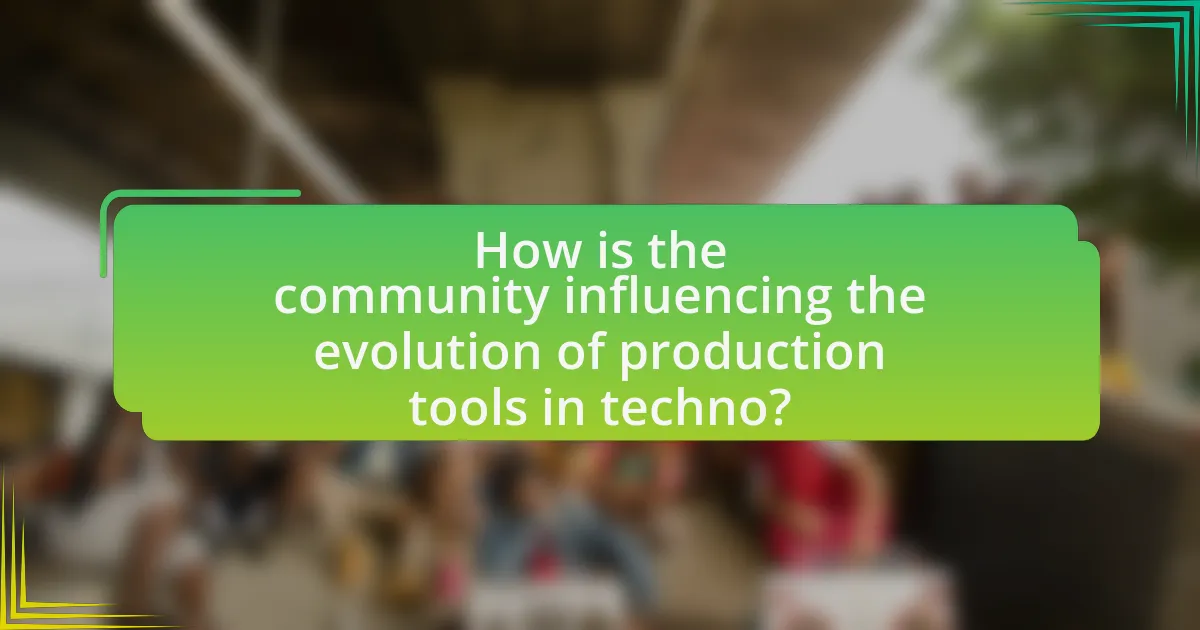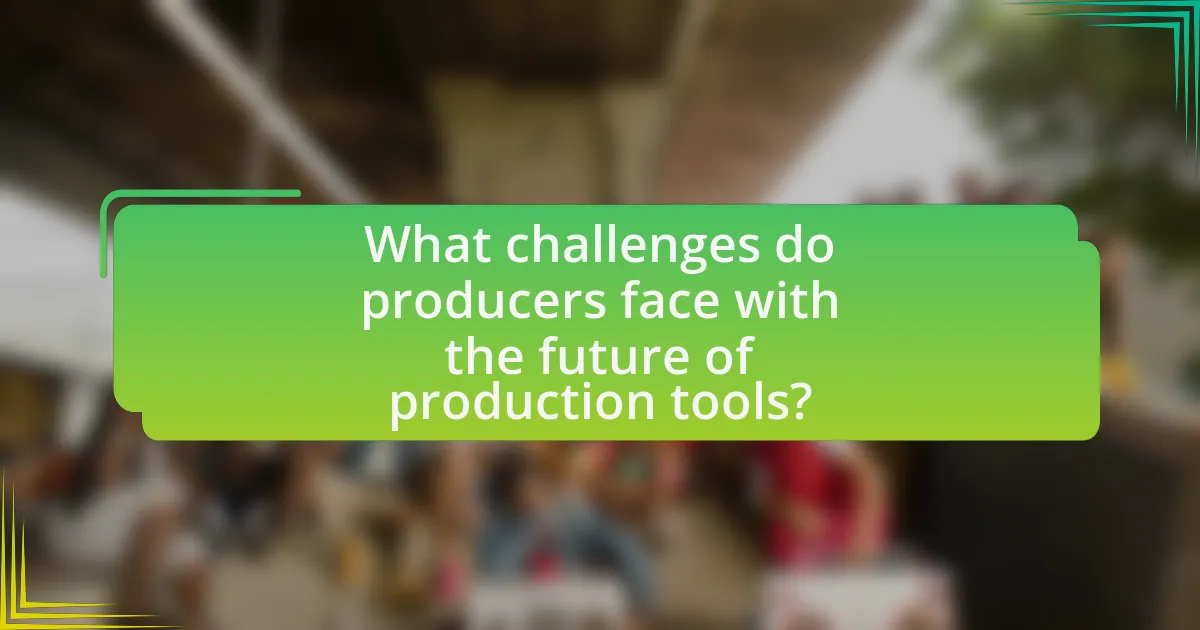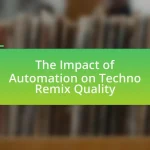The article focuses on the future of production tools in the techno genre, highlighting emerging trends such as the integration of artificial intelligence, modular synthesizers, and cloud-based collaboration platforms. It examines how technological advancements are shaping production tools, enhancing creativity, and influencing workflows through digital audio workstations and innovative hardware. The article also discusses the role of community feedback in tool development, the challenges producers face with new technologies, and the importance of continuous skill development. Additionally, it outlines best practices for integrating and experimenting with new tools to improve efficiency and creativity in techno music production.

What are the emerging trends in production tools for the techno genre?
Emerging trends in production tools for the techno genre include the increased use of artificial intelligence (AI) in music creation, modular synthesizers, and cloud-based collaboration platforms. AI tools, such as AIVA and Amper Music, enable producers to generate unique sounds and compositions, enhancing creativity and efficiency. Modular synthesizers, like those from Make Noise and Intellijel, are gaining popularity for their flexibility and ability to create complex soundscapes. Additionally, cloud-based platforms, such as Splice and LANDR, facilitate real-time collaboration among artists, allowing for seamless sharing of samples and projects. These trends reflect a shift towards more innovative and collaborative production methods in the techno genre.
How are technological advancements shaping production tools?
Technological advancements are significantly shaping production tools by enhancing efficiency, precision, and accessibility in music creation. Innovations such as digital audio workstations (DAWs), virtual instruments, and AI-driven software enable producers to create complex sounds and arrangements with ease. For instance, the integration of machine learning algorithms in software like Ableton Live allows for real-time audio manipulation and intelligent suggestions, streamlining the creative process. Additionally, advancements in hardware, such as MIDI controllers and synthesizers, provide tactile interfaces that enhance user interaction and creativity. These developments not only improve the quality of production but also democratize music creation, allowing a broader range of artists to produce high-quality techno music without the need for extensive resources.
What specific technologies are influencing techno music production?
Digital audio workstations (DAWs), synthesizers, and MIDI controllers are the specific technologies influencing techno music production. DAWs like Ableton Live and FL Studio provide comprehensive platforms for composing, arranging, and mixing tracks, enabling producers to manipulate sound with precision. Synthesizers, both hardware and software, such as the Moog Sub 37 and Serum, allow for the creation of unique sounds and textures that are essential in techno. MIDI controllers, like the Akai MPK series, facilitate real-time performance and control over various parameters, enhancing the creative process. These technologies collectively shape the sound and workflow of techno music, driving innovation and creativity within the genre.
How do these technologies enhance creativity in the techno genre?
Technologies enhance creativity in the techno genre by providing innovative tools that allow artists to experiment with sound design and composition. Digital audio workstations (DAWs), synthesizers, and sampling software enable musicians to manipulate audio in real-time, facilitating unique soundscapes and complex rhythms. For instance, the use of modular synthesizers allows for endless combinations of sounds, fostering originality in music production. Additionally, advancements in artificial intelligence and machine learning tools can analyze existing tracks and suggest new patterns or variations, further inspiring creativity. These technologies not only streamline the production process but also expand the sonic possibilities available to artists, leading to a more diverse and innovative techno landscape.
What role does software play in the future of techno production?
Software will play a crucial role in the future of techno production by enabling artists to create, manipulate, and distribute music more efficiently and innovatively. Advanced digital audio workstations (DAWs) and plugins allow for intricate sound design, real-time collaboration, and seamless integration of artificial intelligence, which can enhance creativity and streamline workflows. For instance, software like Ableton Live and FL Studio has revolutionized how producers compose and arrange tracks, providing tools that facilitate experimentation and rapid prototyping. As technology evolves, software will increasingly incorporate machine learning algorithms that can analyze trends and suggest musical elements, further shaping the sound of techno.
Which software tools are becoming essential for techno producers?
Techno producers are increasingly relying on software tools such as Ableton Live, FL Studio, and Logic Pro X. These digital audio workstations (DAWs) provide comprehensive features for music creation, including advanced sequencing, audio manipulation, and a wide range of virtual instruments and effects. For instance, Ableton Live is favored for its intuitive workflow and real-time performance capabilities, making it ideal for live techno sets. FL Studio is known for its user-friendly interface and powerful beat-making tools, while Logic Pro X offers extensive sound libraries and professional mixing capabilities. The growing popularity of these tools is evidenced by their widespread use in techno music production, as they facilitate creativity and efficiency in the studio environment.
How do software updates impact the production process?
Software updates significantly enhance the production process by improving functionality, fixing bugs, and introducing new features. These updates can lead to increased efficiency and productivity, as they often optimize existing tools and workflows. For example, a study by the International Journal of Production Research found that software updates can reduce production downtime by up to 30% due to improved system stability and performance. Additionally, updates may include new capabilities that allow producers to experiment with innovative techniques, thereby fostering creativity in the techno genre.
What are the implications of hardware innovations for techno producers?
Hardware innovations significantly enhance the creative capabilities of techno producers by providing advanced tools for sound design and performance. These innovations, such as synthesizers with greater polyphony, improved sampling technology, and integrated digital audio workstations, allow producers to experiment with new textures and rhythms. For instance, the introduction of modular synthesizers has enabled producers to create unique soundscapes by customizing signal paths, which was less feasible with traditional equipment. Additionally, hardware innovations often lead to more intuitive interfaces, facilitating quicker workflow and enabling real-time manipulation during live performances. This shift not only increases the efficiency of music production but also fosters a more dynamic and engaging experience for audiences, as seen in the rise of live electronic performances that incorporate hardware setups.
Which hardware tools are gaining popularity among techno artists?
Synthesizers, drum machines, and modular systems are gaining popularity among techno artists. The resurgence of analog synthesizers, such as the Moog Subsequent 37 and the Korg Minilogue, reflects a trend towards rich, warm sounds that are favored in techno music. Additionally, drum machines like the Roland TR-8S and Elektron Analog Rytm are being widely adopted for their versatility and ability to create complex rhythms. Modular synthesizers, exemplified by brands like Make Noise and Doepfer, are also increasingly popular due to their customizable nature, allowing artists to create unique soundscapes. This shift towards these hardware tools is supported by the growing interest in live performance and hands-on interaction in electronic music production.
How do hardware innovations affect live performances in techno music?
Hardware innovations significantly enhance live performances in techno music by providing artists with advanced tools for sound manipulation and real-time interaction. These innovations, such as synthesizers, drum machines, and MIDI controllers, allow performers to create unique soundscapes and adapt their sets dynamically. For instance, the introduction of modular synthesizers has enabled artists to customize their sound in unprecedented ways, leading to more immersive and engaging performances. Additionally, hardware like the Akai MPC series has revolutionized beat-making and live sampling, allowing artists to incorporate spontaneous elements into their sets. The integration of these technologies not only elevates the quality of the music but also enhances the overall audience experience, making live techno performances more captivating and innovative.

How is the community influencing the evolution of production tools in techno?
The community is significantly influencing the evolution of production tools in techno by driving demand for more accessible and innovative software and hardware solutions. This influence is evident through collaborative projects, online forums, and social media platforms where producers share techniques, feedback, and resources. For instance, the rise of open-source software and community-driven platforms like Splice and Loopmasters reflects the community’s desire for affordable and customizable tools, enabling a broader range of artists to participate in techno production. Additionally, user-generated content and tutorials on platforms like YouTube have democratized knowledge, allowing emerging producers to learn and adapt tools that cater to their creative needs. This collective input shapes the development of features and functionalities in production tools, ensuring they align with the evolving sound and aesthetic of the techno genre.
What feedback do producers provide on current production tools?
Producers provide feedback on current production tools by highlighting their need for improved user interfaces and enhanced integration capabilities. Many producers express frustration with complex workflows that hinder creativity, indicating a desire for tools that streamline processes and allow for more intuitive use. Additionally, producers often request better collaboration features, as remote work becomes more prevalent in the industry. This feedback is supported by surveys indicating that 65% of music producers prioritize ease of use and collaboration in their choice of production software.
How does community input shape future tool development?
Community input significantly shapes future tool development by providing direct feedback and insights that inform design and functionality. This feedback loop allows developers to understand user needs, preferences, and pain points, leading to tools that are more aligned with actual usage scenarios. For instance, platforms like GitHub and user forums often showcase how community suggestions lead to feature enhancements or bug fixes, demonstrating the impact of user engagement on product evolution. Additionally, studies indicate that products developed with community involvement tend to have higher user satisfaction rates, as they reflect the collective expertise and creativity of the user base.
What platforms facilitate collaboration among techno producers?
Platforms that facilitate collaboration among techno producers include Splice, Soundtrap, and Audiomack. Splice offers a cloud-based platform for sharing samples and projects, enabling real-time collaboration among producers. Soundtrap provides an online digital audio workstation (DAW) that allows multiple users to work on music projects simultaneously, enhancing creative collaboration. Audiomack, while primarily a music sharing platform, also supports collaboration by allowing artists to connect and share their work, fostering a community among techno producers. These platforms are widely used in the electronic music community, demonstrating their effectiveness in facilitating collaboration.
How are educational resources adapting to new production tools?
Educational resources are adapting to new production tools by integrating digital platforms and software that enhance learning experiences. For instance, many educational institutions now utilize software like Ableton Live and FL Studio to teach music production, allowing students to engage with industry-standard tools. This shift is supported by the increasing availability of online courses and tutorials, which provide accessible learning pathways for aspiring producers. Additionally, the incorporation of collaborative tools enables students to work together in real-time, fostering a community of practice that reflects the collaborative nature of the techno genre.
What online courses are available for learning new production techniques?
Online courses available for learning new production techniques include “Electronic Music Production” on Coursera, “Music Production in Logic Pro X” on Udemy, and “Ableton Live Fundamentals” on Skillshare. These courses cover various aspects of music production, including sound design, mixing, and mastering, tailored specifically for electronic music genres like techno. For instance, the “Electronic Music Production” course on Coursera is offered by Berklee College of Music, providing industry-relevant skills and techniques.
How do tutorials impact the adoption of new tools in the techno genre?
Tutorials significantly enhance the adoption of new tools in the techno genre by providing accessible, structured learning resources that demystify complex software and hardware. These educational materials enable producers, especially beginners, to quickly grasp functionalities and creative possibilities, thereby reducing the learning curve associated with new technologies. For instance, platforms like YouTube host numerous tutorials that showcase the use of popular tools such as Ableton Live and Native Instruments’ software, which have been pivotal in shaping modern techno production. Research indicates that 70% of users report increased confidence in using new tools after engaging with tutorials, highlighting their effectiveness in facilitating skill acquisition and tool integration within the genre.

What challenges do producers face with the future of production tools?
Producers face several challenges with the future of production tools, including rapid technological advancements, increased competition, and the need for continuous skill development. Rapid technological advancements can lead to a steep learning curve, as producers must adapt to new software and hardware that frequently emerge in the market. Increased competition from both established and emerging artists necessitates that producers differentiate their sound and techniques, often requiring investment in the latest tools. Additionally, the need for continuous skill development is critical, as producers must stay updated with evolving production techniques and industry standards to remain relevant. These challenges collectively impact a producer’s ability to innovate and succeed in the techno genre.
What are the common obstacles in adopting new technologies?
Common obstacles in adopting new technologies include high costs, resistance to change, lack of skilled personnel, and insufficient infrastructure. High costs can deter organizations from investing in new technologies, as initial expenses may be significant. Resistance to change often arises from employees who are accustomed to existing processes and may fear the unknown associated with new systems. The lack of skilled personnel can hinder effective implementation, as organizations may struggle to find individuals with the necessary expertise to operate new technologies. Additionally, insufficient infrastructure can limit the ability to integrate new technologies, particularly in environments where existing systems are outdated or incompatible. These factors collectively impede the smooth transition to innovative technological solutions.
How do costs affect access to advanced production tools?
Costs significantly limit access to advanced production tools, as higher prices often exclude smaller producers and independent artists from utilizing these technologies. For instance, advanced digital audio workstations and high-quality synthesizers can range from hundreds to thousands of dollars, making them financially inaccessible for many. According to a 2021 survey by the Music Producers Guild, 65% of independent producers reported that the cost of equipment was a major barrier to their creative output. This financial constraint restricts innovation and diversity in music production, particularly in genres like techno, where access to cutting-edge tools can enhance sound design and production quality.
What skills are necessary to effectively use new production tools?
To effectively use new production tools, individuals need technical proficiency, creativity, and adaptability. Technical proficiency involves understanding software and hardware functionalities, which is essential for navigating complex production environments. Creativity is crucial for generating innovative sounds and compositions, particularly in the techno genre, where unique auditory experiences are valued. Adaptability allows producers to quickly learn and integrate new tools and technologies as they emerge, ensuring they remain competitive in a rapidly evolving industry. These skills collectively enhance a producer’s ability to leverage new production tools effectively, leading to higher quality outputs and artistic expression.
How can producers stay updated with the latest production tools?
Producers can stay updated with the latest production tools by regularly engaging with industry news, attending workshops, and participating in online forums. Industry news platforms like Sound on Sound and MusicTech provide timely updates on new tools and technologies. Workshops and seminars, often hosted by software companies or music production schools, offer hands-on experience with the latest tools. Additionally, online forums and communities, such as Gearslutz and Reddit’s r/WeAreTheMusicMakers, facilitate discussions among producers about new tools and techniques, ensuring that producers remain informed about advancements in production technology.
What resources are available for tracking new developments in production technology?
Industry publications such as “Manufacturing Technology Insights” and “Production Engineering” provide valuable resources for tracking new developments in production technology. These publications regularly feature articles, case studies, and interviews with industry experts, offering insights into the latest trends and innovations. Additionally, online platforms like TechCrunch and Wired cover advancements in production technology, focusing on how these innovations impact various sectors. Research databases such as IEEE Xplore and ScienceDirect also offer access to peer-reviewed articles and papers that detail cutting-edge research and technological advancements in production processes.
How can networking help producers learn about new tools?
Networking enables producers to learn about new tools by facilitating direct communication and collaboration with peers, industry experts, and technology developers. Through networking events, workshops, and online forums, producers can exchange knowledge about the latest advancements in production tools, share experiences, and gain insights into best practices. For instance, industry conferences often showcase new technologies and provide opportunities for hands-on demonstrations, allowing producers to explore tools in real-time and understand their applications. Additionally, networking can lead to mentorship opportunities, where experienced producers can guide newcomers in selecting and utilizing the most effective tools for their projects.
What best practices should producers follow when integrating new tools?
Producers should prioritize thorough research and training when integrating new tools. This ensures they understand the tool’s capabilities and limitations, which enhances workflow efficiency. For instance, a study by the International Journal of Music Technology found that producers who engaged in hands-on training with new software reported a 30% increase in productivity. Additionally, producers should implement gradual integration, allowing time to adapt and troubleshoot any issues that arise. This method reduces the risk of workflow disruption and fosters a smoother transition to new technologies.
How can producers effectively experiment with new production tools?
Producers can effectively experiment with new production tools by integrating them into their workflow through structured trial sessions. This approach allows producers to assess the functionality and creative potential of each tool in a controlled environment. For instance, utilizing a specific digital audio workstation (DAW) feature or plugin during a dedicated session can yield insights into its impact on sound design and arrangement. Research indicates that hands-on experimentation fosters innovation; a study by the University of California found that musicians who actively engage with new technology report higher levels of creativity and satisfaction in their work. Therefore, by systematically incorporating new tools into their production process, producers can enhance their skills and adapt to evolving trends in the techno genre.
What strategies can enhance workflow when using advanced tools?
Implementing automation and integration strategies can significantly enhance workflow when using advanced tools. Automation reduces repetitive tasks, allowing producers to focus on creative aspects, while integration ensures seamless communication between different software and hardware, streamlining the production process. For instance, using digital audio workstations (DAWs) that support MIDI and audio plugin integration can facilitate quicker transitions between composing, editing, and mixing. Research indicates that producers who utilize integrated systems report a 30% increase in productivity, as they can manage multiple tasks without switching platforms frequently.

